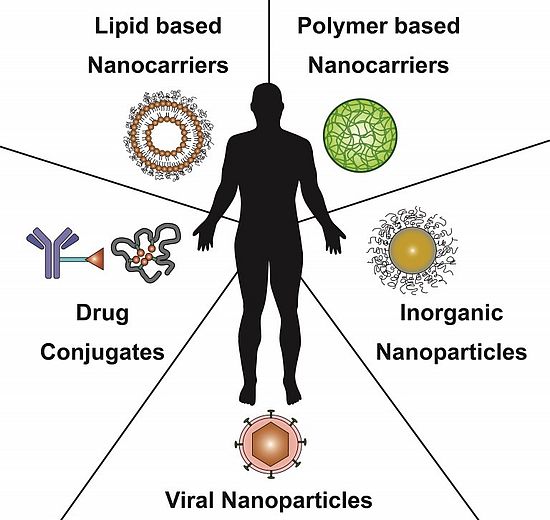Different Delivery Sytems - Liposomes, Polymer NPs, Silica, Iron

Cancer therapy is a very broad medical field with various different treatment approaches. One possibility is the usage of nanoparticles. They are able to kill tumor cells either directly (e.g. via oxidative stress or DNA damage), or they act as carriers for anti-tumor agents. Using such a nanocarrier approach enables therapeutic agents to permeate efficiently and specifically into tumor tissue via passive or active targeting resulting in reduced side effects in normal tissue.
A wide range of nanomaterials based on organic, inorganic, lipid, protein, or glycan compounds as well as on synthetic polymers have been employed for the development of new cancer therapeutics (Kettiger et al. 2013; Wicki et al. 2015).
Lipid-based nanocarriers are the most widely studied drug delivery systems and several clinical trials are ongoing. Pegylated liposomal doxorubicin (Doxil® or Caelyx®) was the first nanocarrier approved by the US Food and Drug Administration in 1995. While liposomal formulations allow for stable encapsulation of a drug, they do not address the issue of targeted delivery. To achieve true targeted delivery, liposomes must be modified on their surface with an agent that confers specificity. One possible approach is the conjugation of glycoproteins, antibodies, antibody fragments, or single-chain antibodies to the liposomal surface (Detampel et al. 2014).
One example for targeted polymeric nanoparticles are poly(ethylene glycol)-b-poly(ε-caprolactone) solid-sphere nanoparticles (SNPs). They were covalently linked to a monoclonal antibody targeted against the human insulin receptor that is highly expressed on human brain microvascular endothelial cells. These SNPs are a promising candidate to deliver drugs to the central nervous system (Grossen et al. 2016; Grossen et al. 2017).
Inorganic nanoparticles are used for a variety of applications, including tumor imaging, enhancement of radiotherapy, or drug delivery. Iron oxide nanoparticles are mainly used for diagnostic purposes and some are tested in clinical studies for magnetic resonance imaging of tumors (Kettiger et al. 2013; Wicki et al. 2015).
Nanomedicine is as one of the most promising and advanced approaches in the development of frontier cancer treatment. Thousands of publications suggest that nanomedicine therapeutics are effective in cancer treatment, both in vitro and in vivo. However, only very few nanocarrier-based cancer therapeutics have successfully entered clinical trials. Thus, it is important to address the challenges in developing optimized nanomedicine products for clinical use.
